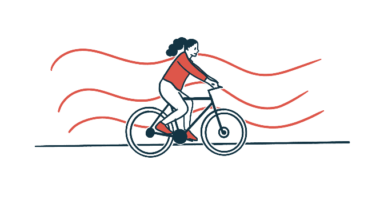Walking Program Adds to Benefits of Respiratory Muscle Training

A walking program seems to boost the benefits of respiratory muscle training — which consists of specific exercises designed to improve the function of muscles used in breathing — in people with Parkinson’s disease, a small study has found.
In the study, patients who followed an eight-week walking program in addition to respiratory muscle training had greater improvements in their ability to exhale air compared with patients who had respiratory muscle training only.
The study, “Walking training augments the effects of expiratory muscle training in Parkinson’s disease,” was published in Acta Neurologica Scandinavica.
Some people with Parkinson’s disease experience breathing problems, including shortness of breath and sleep breathing disorders. Their breathing muscles may become weakened, potentially resulting in decreased exercise capacity, which translates into decreased physical activity and walking difficulties.
Studies have shown that respiratory muscle training can be an effective approach to strength breathing muscles. Walking may have similar effects.
“Walking with the appropriate intensity, frequency, and duration, which is an easily applicable type of exercise, would provide improvement in respiratory muscle strength and function in patients with Parkinson’s disease,” the researchers wrote.
However, no study so far has evaluated the potential added benefits of walking when combined with respiratory muscle training.
To address this, a team of researchers in Turkey compared lung function, breathing muscle strength, and exercise capacity in 14 Parkinson’s patients (mean age of 62.3 years) undergoing respiratory muscle training and 15 patients (mean age of 59.3 years) receiving respiratory muscle training plus walking training.
All patients received respiratory muscle training using threshold loading — a method of incrementally loading the breathing muscles — for both inspiratory and expiratory muscle training. The training was repeated twice daily at home for eight weeks, at least five days per week. Each session lasted 30 minutes (15 minutes of inspiratory plus 15 minutes of expiratory muscle training). Patients who also had walking training did so at least five days per week, twice daily, for 15 minutes each time.
After the eight weeks of training, both groups achieved greater breathing muscle strength and six-minute walking distances (6-MWD), a measure of exercise capacity. Although the increase in 6-MWD was greater in the group with both types of training, the difference was not statistically significant.
The Unified Parkinson’s Disease Rating Scale scores, a measure of motor symptoms, decreased in all patients, indicating an improvement in health status.
A measure of the maximal effort exerted by breathing muscles during a forceful exhalation of breath, called the maximal expiratory pressure, was higher in patients who had respiratory muscle training plus walking training than in patients who had respiratory muscle training only.
These data suggest that “walking training given in addition to [respiratory muscle training] provided an additional increase in expiratory muscle strength, and it was found to be an effective treatment that could increase walking distance,” the researchers wrote.
As part of the study, patients were asked to keep a diary of all their training sessions and reported no problems in performance.
“The patients’ compliance with the training was good,” the researchers wrote, adding that “patients reported that they had no symptoms such as dizziness, palpitation, fatigue, and felt less tired from their activities of daily living.”
Exercise guidelines by the Parkinson’s Foundation and the American College of Sports Medicine recommend 30 minutes or more of aerobic activity such as brisk walking at moderate to vigorous intensity, three days per week. Supervision may be required due to concerns regarding freezing of gait, low blood pressure, or blunted heart rate.







